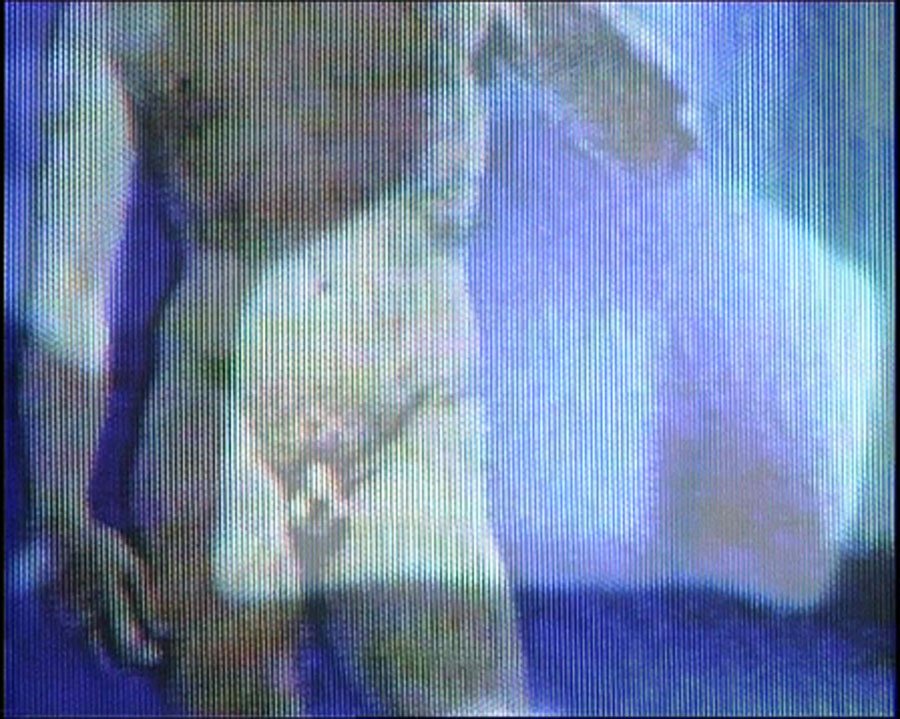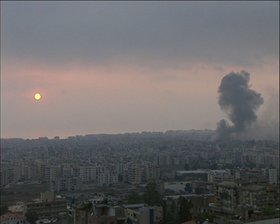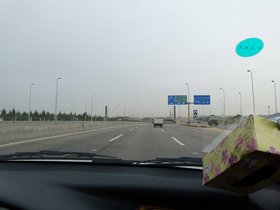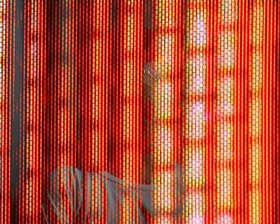The Video That Exploded: Roy Samaha in conversation with Anthony Downey
02 November 2012
Roy Samaha is a Lebanese artist based in Beirut. Practicing with video and photography since 2002, he has exhibited in numerous film and contemporary art festivals. Between 1998 and 2008, he worked in the television industry as part of his field research on electronic media. He got his Master’s degree in film studies at USEK, Lebanon. Currently, he is giving seminars on alternative video practices in different universities in Beirut. In this conversation with Anthony Downey, he talks about the various influences on his work, including William Burroughs, and how technology affects not only how we perceive the world but changes modes of perception over time. In visually dense videos, which draw on multiple sources of imagery, Samaha explores the effect of technology upon his own perceptions of reality and what an excess of communication can do to how we understand events such as those in Tahrir Square during the revolution in Egypt, not to mention the long-term effects of video technology in determining how we perceive the world.
Anthony Downey: I want to begin by talking about the project you are working on for Ibraaz – I understand there have been difficulties developing it.
Roy Samaha: Before I went to Cairo to do this project, I was going to do a completely different one that involved a road trip from Beirut to Damascus, down to Amman, all the way to the south of Jordan and then across the Red Sea by boat up to Sinai – to do a whole road trip crossing from Asia-Middle East to Africa-Middle East. This was the initial project that I was planning for in December 2010. I had made some drawings and I had some pictures that I had taken a year or two before on almost the same trip. I wanted to do it properly over two to three weeks, travelling by land and by sea all the way to Aswan in the south of Egypt. I have a few documents about that project but when the revolution started in January 2011, I just put everything in a drawer and got on a plane to Cairo to be there as soon as possible.
AD: This project came out of an ambition to retrace the footsteps of James Bruce, the Scottish explorer, who tried to find the Blue Nile?
RS: Yes, I wanted to retrace his route and I became interested in that project because it had the feeling of time travel to it, of retracing the physical steps of someone but also retracing it in time. So I prepared my old archive and pictures that I had taken in Syria and Jordan and I did some research – but on the 25th of January, it was all shut down and I took a plane to Cairo, where I caught the first week of the revolution. I thought that I could present this project with Ibraaz as a failed project – the actual road trip to Aswan.AD: What I want to do now is to go back and look at your earlier work. One of this first works of yours that I saw was Untitled For Several Reasons (2002-2003) and I was very taken by a number of things. There is a sort of flux of imagery – a form of retinal zapping whereby the eye finds it difficult to accustom itself to the imagery. Could you talk about that work in particular because it seems to be integral to your work as a whole?
RS: This was actually my first officially released video. I had done some before but they were more like sketches for this one, which took three years to finalise in the format that you now see it. It started with some sketches from 2000. Two years earlier, I was just getting accustomed to the Internet, which was then really starting to boom. I was young then, just 22 years old. I wanted to work within the speed of communication and transmission of information and the way in which we are bombarded with it. It happened that I stumbled upon a book by William Burroughs called The Ticket That Exploded (1962). It’s an amazing book and it opened my mind a lot, especially the last chapter entitled ‘The Invisible Generation’, where Burroughs describes how to use an audio tape recorder in an effective way. The chapter resembles Hakim Bey’s essay Poetic Terrorism, published in 1991. Burroughs seemed to be asking how could you record everything that you receive and play it back on the spot and how could this generate new events – not only receiving information but by using this information to generate events? The title for my video Untitled for Several Reasons was scripted by the book. It’s a narrative book, which unfolds over a sequence of pages, and you have descriptions of video screens going insane and causing visual riots through the production of images.
AD: Did you use found imagery?
RS: I don’t know if I want to go into these details but I went through a very weird period in my life when I was working as a night shift security guard in a drug store. I was reading Burroughs to pass the time between 12am and 7am. When I was doing this job, I was still at university. I would come back in the morning, unable to sleep, and so I would go online, chat, watch videos. Within a two-month period I started to work on the piece and to edit it and narrate the story of this person who goes through a certain transformation.
AD: One thing that comes out in Burroughs’ book is the notion of social revolution through the use of technology. If I remember rightly, there is a detective, Agent Lee, who is an investigative persona who goes in search of narratives and ideas. It seems to me that one of the key things about Untitled for Several Reasons is that it is about the idea of perception itself, or technological perception.
RS: Exactly. By that time I was starting to think about an altered space of perception. I was always concerned with notions of what it is to be under very unusual circumstances in which your perceptions are changed, especially through sleep deprivation and intoxication. The medium of the video itself is a machine that transforms life and events into an electronic signal and those signals are then all gathered in a swamp of information. Once they are transformed from the original state of perception, which is everything we see with our eyes or through the camera lens, this fog of information made from electrons can be accessed and altered at any moment. Then I saw a kind of analogy with what happens to our perception when we are in an abnormal state of mind and when there is an accident in the machine itself and the image gets distorted – thunderstorms, atmospheric variations, anything that can disturb this cloud of electronic information.
AD: Bearing in mind that you were looking at William Burroughs, did you come across Brion Gysin at any point and the dream machine?
RS: Yes I actually saw it in New York at the New Museum, two years ago. They had an amazing retrospective of Gysin’s work.
AD: I am also thinking of Video for the End of Time here, as there are some aesthetic cross-overs to be had withUntitled for Several Reasons – it is a visual cacophony. But with Video for the End of Time (2006), which uses the compositions of Olivier Messiaen, there seems to be a working through of this cacophony and perhaps towards the end we have something more concentrated, something more focused – I’m thinking of the seagull flying in the sky. Suddenly things become less cacophonous and less unclear. Would that be a reasonable interpretation of that work?
RS: Yes, this video came after Untitled For Several Reasons but in-between them I made a very short piece, a performance video called Pink, White, Green, Black (2005). Those three videos are a kind of trilogy, a progression. They can be watched separately, but if someone were to watch them together, they would feel a kind of transformation. You have a literal break in Pink, White, Green, Black; it was also a kind of transition in my life. After Pink, White, Green, Black, I stopped working for two years and then I finished with Video for the End of Time. So between 2002 and 2006, there are three videos in total.
AD: Let’s look at Pink, White, Green, Black. One thing that struck me about this work was both a sense of individual dislocatedness and formal dislocatedness. The work that it brought to mind for me was Bill Viola’sReasons for Knocking at an Empty House (1982). Have you seen it?
RS: No, I haven’t had the chance but I have his book. It’s an installation, right?
AD: Yes, and it draws me back to the previous discussion we were having about how altered states of mind also alter how one views and perceives the world. Viola tried to stay awake for a period of time, two days or so, and eventually his perception of events becomes disoriented – this is what he attempts to capture in the video. I noticed in Pink, White, Green, Black this sense of personal dislocatedness and disorientation, this problem with perception and how that is mirrored in the formal use of the technology breaking down. Is that a fair thing to say about that work?
RS: Yes, definitely. I had experimented a lot during Untitled for Several Reasons and it literally broke me down physically. You enter periods when you want to discover yourself; you want to explore the possibilities and limits of your body and your perception. Sometimes it is unwise to go too far and I was unlucky – it literally broke me down. Pink, White, Green, Black marks that shift where I felt it was impossible to perceive and to move literally – it was a kind of test for me, I had to go through the total annihilation of the body and then a kind of resurrection again. During this time, I was moving from my teenage self into adulthood, and you take advantage of this transition to experiment with you own limits. Eventually, your body will tell you this is it and you stop.
AD: When I watched that film, it seemed to me to be about the limits of subjectivity but also the limits of technology, and it also seemed to me to be about the subject at the limit of technology – an interface between the two limits: the self and technology. Does that make sense?
RS: Definitely. That’s a beautiful interpretation.
AD: It struck me because I watched the films in reverse order and then I watched them in order and it seems that in the third in the series, Video for the End of Time, there seems to be some degree of personal resolution but equally pictorial resolution.
RS: It’s much simpler when it comes to the image. You go through the layers and get to a point where you use the last one you reach. Like Untitled for Several Reasons, at a certain moment the image is made from layering eight video tracks on top of each other. And then in Pink, White, Green, Black, it is broken down into four and then you go back to two. I read something by Carlos Castaneda about how his benefactor told him that in dreams, since you have two eyes and two ears, you have the possibility of separating them and perceiving two different realities. You don’t really have to separate them – you can basically explore the world in a double manner, without being redundant. So it inspired me in the first place and I was layering and layering and you come to a point where you settle with the last one you get.
AD: There is a wonderful film that Video for the End of Time reminds me of and it’s Jean-Luc Godard’s First name: Carmen (1983). There is a scene where a Beethoven string quartet plays – I think it is Opus 132 – over the movement of the sea as waves go in and out. It reminded me very much of the closing scenes of Video for the End of Time just in terms of how I felt towards it – that it was almost melancholic, a portent of an ending.
RS: It is melancholic. I was working as a freelance cameraman for ABC news during the July 2006 war in Lebanon. I was covering the war but I kept a pocket camera with me, so every time I was sent to an assignment, I would be filming around me whenever I was not working. I would record my surroundings as my diary. When it was all over, I watched the one-hour tape and decided to make a video about this period and that is why I called it Video for the End of Time. It has this melancholia to it because I was experiencing the traumas of the war but you have to do your professional job regardless of what you feel because you are paid to do it. The reason for this video was also accidental because I was just recording the ‘dead time’ when I was not working as a cameraman.
AD: Could we speak briefly, and maybe you don’t want to, about your work as a video journalist? Do you think that has in any way informed the formal aesthetic of the videos you make or is there a clear distinction between the two?
RS: The only distinction is just the political position that you take and where you stand in relation to the event. Once again I come back to Burroughs, who has inspired me a lot in my life. He was a journalist as well as a writer. At one point, he says no matter what you do, whether you are a journalist or whatever, it doesn’t matter as long as it covers you enough to work freely and allows you to do your job. He was talking about the fact that we need a society of underground journalists reporting on the world but with a different approach, a different logic, a different syntax altogether. I went into journalism because of that, not just for the money – which I needed at the time to pay for my tuition – but so that I could be up close to reality, rather than just being a student in a cinema dreaming about it. I wanted to get involved deeply, so I chose to do this and it helped me a lot, especially in the latest video,Transparent Evil (2011).
AD: Yes, maybe we could talk a little bit about that now because one of the things that struck me is the process of re-documentation, the way in which you are re-documenting an actual journey that occurred at a certain point in time. Do you see it as a process of re-documentation or is it an intervention into time and space?
RS: That’s a tricky question. Well, I did go to Cairo. I spent a week there and I documented everything I saw and I used this and the emptiness of Cairo to create a new narrative. I wouldn’t say I took advantage of the situation but it inspired me. When you move away from Tahrir Square, you have this emptiness and silence and it inspired me to make interventions – to ask my friends to film some stuff so I could use Cairo as a set for the film, as a movie set.
AD: You chose – and this goes back to what you said about video journalism, where one stands in relation to events – not to look at the obvious media event of Tahrir Square, but elsewhere. There seemed to be a very specific motivation in not looking at the media event.
RS: I just decided to take the images that were not out there during this period. I felt that the protests were important to document but also the emptiness of Cairo and the silence of the set were important events in themselves, because they were created by this situation. So I said to myself I would explore this area. In any case, I would have been flooded with images, as we were all flooded with images of the square itself and the event, which I used from You Tube and put in the narrative. I did film some protests but I barely used it. I preferred to use images of protests that were filmed by the protesters themselves.
AD: I am going to quote you a sentence from the text that comes with the video, which I was very taken by. It comes near the end of the text itself: ‘This is the ecstasy of communication, this is the electronic revolution’. I was very taken by the word ‘ecstasy’ because it is a form of excess but it also involves a degree of terror. It is also quite mystical with regards to perception or prophetic exaltation and I was wondering if any of these words chime with what you were looking at in relation to the film?
RS: Yes, there is a lot of that. To rephrase what you said: this abundance and availability and speed is somehow ecstatic and I am trying in this work to make a small tribute and reply to Jean Baudrillard, who wrote a book called The Ecstasy of Communication (Foreign Agents) (1987). At this time, he had maybe ten percent of what we have in terms of speed of communication and abundance of information. I thought a lot about this book when I was writing my thesis, and it stayed with me in parallel to William Burroughs, who was concerned with the same issues but who took a different approach to it. Burroughs was calling for an electronic revolution in the 1970s, and then you had Baudrillard criticising the loss of values and boundaries wherein which we become schizophrenics who are open and permeable to anything without any defence.
AD: Technology is not only dictating what we see but it is dictating how we see it, it is predicating how we can perceive reality itself. What I get with Transparent Evil is that inherent within the ecstasy of communication – the proliferation of images, the technological advancement – is an almost a prophetic terror about what this is doing to reality itself. Would you agree with that?
RS: Sure, not only with reality but to our own psyches as well, the way we deal with it. I don’t think the human body is made to take in that much. We have accommodated a lot and nobody knows how much more we can take. Yes, there is a terror. It is not something natural to us as human beings.
AD: Do you see a relationship between the terror of images and current events in the region? Say, in Egypt and Syria, where imagery is proliferating, coming through different channels, being produced on multiple levels and producing almost a cacophony of imagery whereby it is difficult to stand either the imagery or the reality? Is there any connection between these things for you?
RS: Between what exactly?
AD: Put more simply: within the proliferation of images that we see presently in the region in and around protests, do you see something akin to what we just discussed – the terror and horror of having to assimilate so much imagery and what that imagery is doing to the reality of the event itself?
RS: It’s a bit tricky. I am still debating this idea in my head. Do we really need to see that much of anything? I am someone who deals with video, the most popular medium on the planet. Everybody uses video, whether artists, journalists, whatever – you will use video at least once in your lifetime. This is why I am always concerned with this production and this is partly why I spent two or three years doing nothing but think about the structure, about the medium itself, after which time I could move to still photography and just relax and contemplate the stillness of still pictures, though I was always thinking about video. I am still thinking about it – I have been considering this question since I started working with video. Do we need it? How much do we need? Since we cannot stop it, because that would be unrealistic, should we work with it and if we work with it, what should we do with it? These kinds of questions, which are more concerned with the medium itself, and also bringing it back to the body, are important.
Reference
Samaha, Roy. “The Video That Exploded Roy Samaha in Conversation with Anthony Downey.” Interview by Anthony Downey. Ibraaz. Ibraaz, 2 Nov. 2012.



